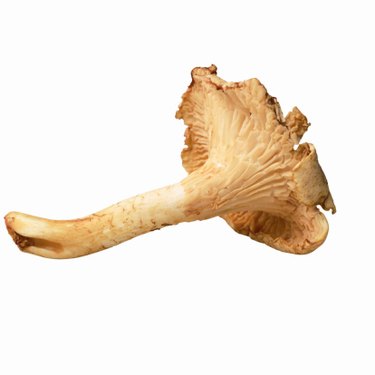
During autumn, right after the first rain of the season, the wild edible mushrooms in Humboldt County, California start to push through the soil. While most Humboldt County mushrooms can take anywhere from a few days to a few weeks to appear, they are all most certainly worth the wait to any mushroom-lover.
The King Bolete
Video of the Day
There is no mushroom that gets bigger in size then the king bolete. This mushroom achieves a size no other Humboldt County edible mushroom can achieve and is the easiest edible mushroom to identify. The Boletus edulius, also known as a porcini in Italy, a cep in France and stinpilz in Germany, has more than 20 species. Reported measurements have recorded sizes up to 12 inches by 12 inches and they can weigh as much as 4 lbs. each. The drawback of the king bolete is that, many times, when a mushroom has grown to a large size, it is usually claimed by worms, which is why many people opt for smaller boletes found around the kings in the wild.
Video of the Day
Oyster Mushrooms
The Pluerotis, also known as an oyster mushroom, is another popular wild, edible, mushroom found in Humboldt County. The oyster mushroom gets its name not only because of its similarity in appearance to an oyster, but also because its smell and taste is also similar. Oyster mushrooms have small stalks with oyster-shaped caps and can be found on dead or dying alders, in groups. They are 2 inches to 8 inches wide, tiny in height and recognizable mainly by the caps.
Golden Chanterelles
The Cantharellus cibariusare, also known as the golden chanterelle, are another edible mushroom found in Humboldt County. These mushrooms are usually orange or yellow, very meaty, funnel-shaped and have ridges instead of gills. These are the mushrooms most commonly used in a cream of mushroom soup. Chanterelles can be found growing around spruce trees, under evergreens and also close to huckleberry and sword ferns. These mushrooms have an apricot-like smell and a mild, pepper-like taste and are considered a delicacy in many parts of the world.
Lobster Mushrooms
Hypomyces lactifluorum, also known as the lobster mushroom, are not actually mushrooms, but a mold that grows on mushrooms in the Humboldt County region. The mold turns the mushrooms reddish in color, resembling the outer shell of a lobster. One of the drawbacks is that these lobster mushrooms can commonly cover a mushroom so thoroughly, that the actual species becomes unidentifiable. While the lobster mushrooms still can be identified, the edible ones are very commonly found in large grocer stores and on restaurant menus. True to their name, the mushrooms have a fish-like flavor and a firm, dense texture and may taste spicy.